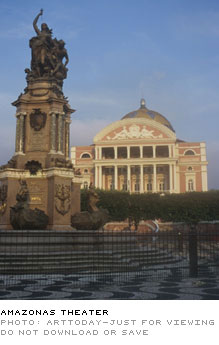|
Manaos, capital of the state of Amazonas in the north of Brazil, has been through all these stages and its inhabitants feel very proud about it. Set deep in the heart of the Amazon jungle, on the left bank of the Rio Negro, 18 kilometers from its junction with the Amazon and over 1,700 kilometers from its outlet, Manaos is surrounded by rain forest and is the only important town for over 1,000 kilometers.
The city dates back to 1669 when Francisco de la Mota Falcao built a mock fortress on the site of a Manao Indians village. It gradually grew and by 1833 was known as Villa de Rio Negro. On September 4th, 1856, the Amazonas Provincial Assembly gave it the name of Manaos, in honor of the first inhabitants of the region, which means "the mother of the gods". Between 1890 and 1910, Manaos changed thanks to the boom of Hevea Brasiliensis (rubber tree) and grew from being an obscure village to a city comparable to major European cities. The buildings of that time still exist as witnesses to its fascinating history. The Floating Dock and the River Port that allow the approach of deep draft ocean-going ships; the Customs House, the first pre-fabricated building in the country; the Municipal Market, a replica of the now defunct "Les Halles" of Paris. In fact, Manaos could boast of street lighting and trams before many European cities.
However, no other building work mirrors the prosperity of this period as does the Amazonas Theater, opened in 1896. Built with materials and the aid of artists brought from Europe, it became the pride of the city. All was abandoned due to the great economic depression brought on by the fall in rubber prices in the world market. Gradually, the jungle began to take over again. But the inhabitants of Amazonas do not give up so easily and in 1967 they began to grow and develop again with the creation of a customs-free area.
Since then the capital of Amazonas has undergone a number of huge transformations and has become an important industrial center for the manufacture of electric and electronic material. Today, it is also an important hub of ecological tourism with a growing infrastructure of luxury hotels, restaurants, tourist guide services and a top class international airport. Of course, with the addition of the immense Amazon rain forest, with its vegetation, wild life and many original options such as the "jungle lodges". Having had a taste of both extreme poverty and fantastic wealth, the inhabitants of Manaos have left these measures of progress forgotten and look towards the future from a new perspective: their own efforts and the defense of their environment that today, just like yesterday, is their real wealth. Manaos, the capital of Amazonas, an example of the best of the latin spirit. |
|
|
 Can
a place in the middle of the jungle be very poor, then very rich,
poor again and finally return to being very prosperous?
Can
a place in the middle of the jungle be very poor, then very rich,
poor again and finally return to being very prosperous?